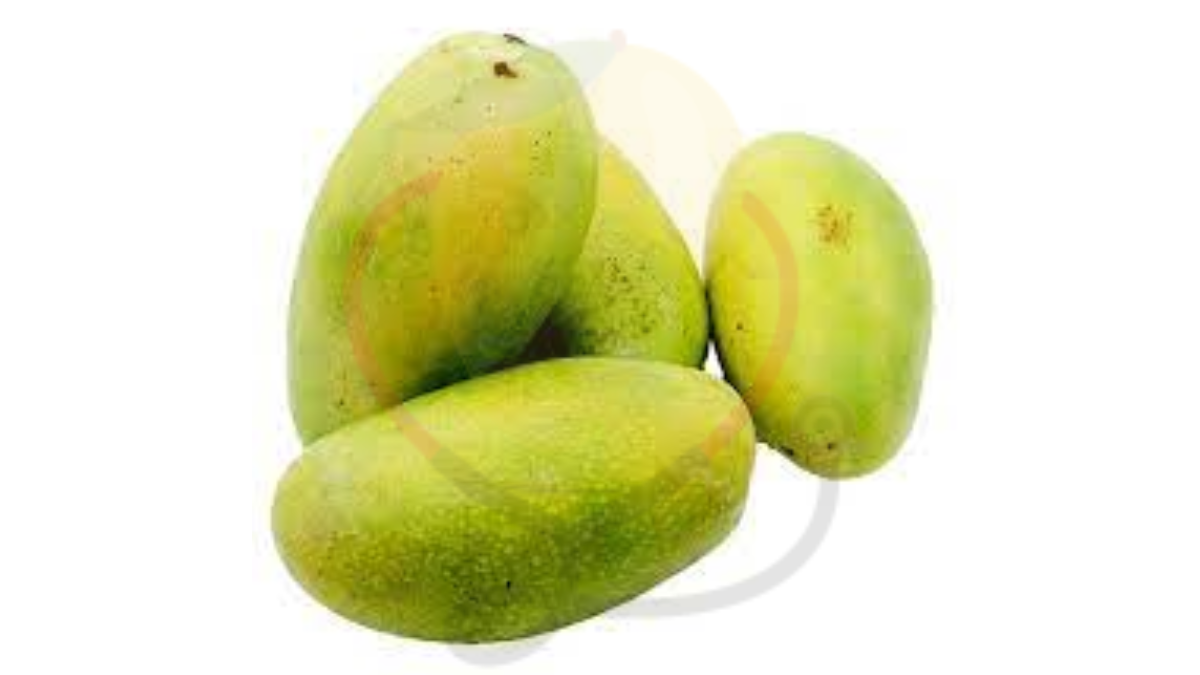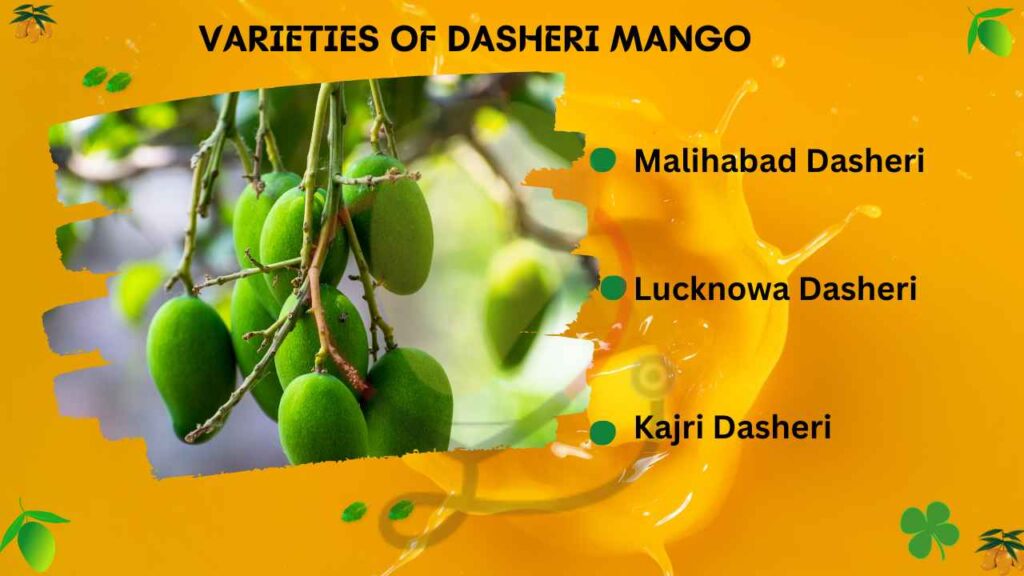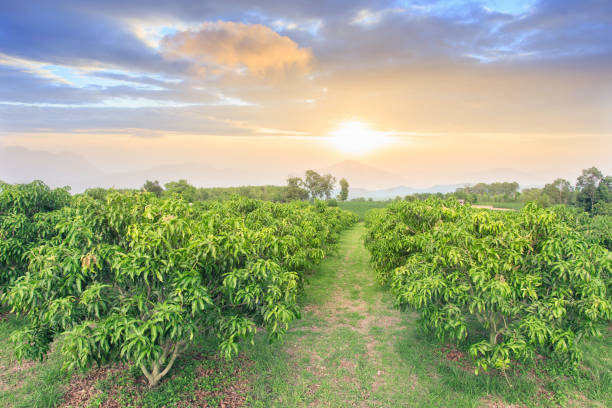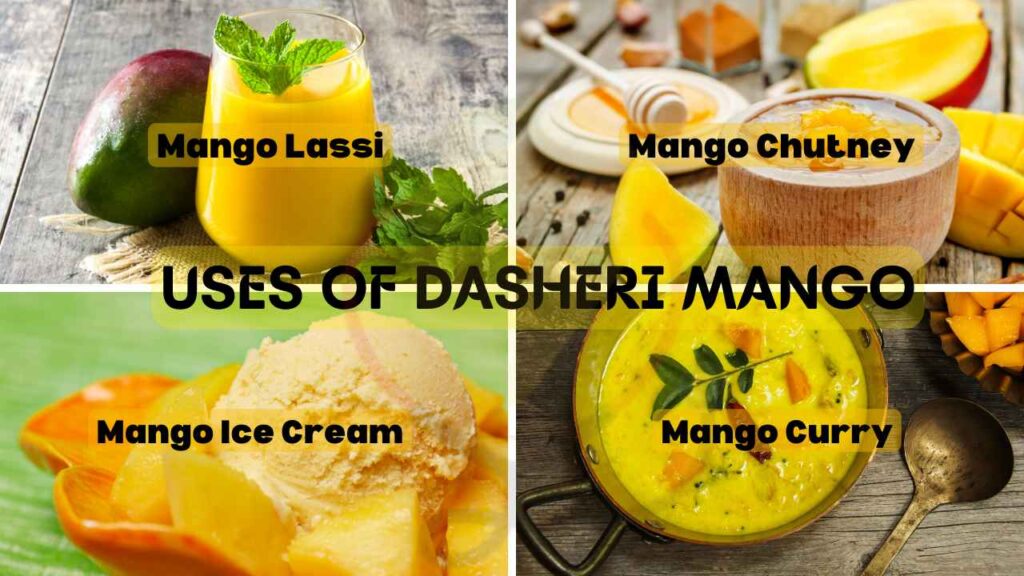Dasheri Mango is a highly sought-after variety of mango that is considered the “King of Mangoes.”
When the fruit is ripe, its semi-thick, smooth, leathery, and slightly waxy skin, initially light green to yellow-green in color, turns into a golden yellow hue. [1]
Dasheri Mango is believed to have originated in the village of Dasheri in Uttar Pradesh, India, during the 18th century. [2]
In this article we will discuss about the dasheri mango’s history, cultivation, uses, health benefits and its recipes.

Varieties of Dasheri Mango
There are several varieties of Dasheri Mango, including the Malihabad Dasheri, Lucknowa Dasheri, and Kajri Dasheri.
The Malihabad Dasheri is the most popular variety and is grown in the Malihabad region of Uttar Pradesh.
Lucknowa Dasheri is a larger and more elongated fruit, while the Kajri Dasheri has a reddish color and is sweeter than the other varieties. [3]

Origin of Dasheri Mango
Dasheri Mango has a long and rich history in Indian culture, dating back to the Mughal era. It was introduced by the Mughal emperors and used as a diplomatic gift.
Today, it is a popular fruit known for its exceptional taste and quality, and it is grown in various regions of India.
Mangos have been cultivated in Southeast Asia and India for thousands of years and are an essential part of India’s rich cultural heritage. [4]
Cultivation of Dasheri Mango
Dasheri Mango is a tropical fruit that requires specific conditions for its cultivation.
The fruit grows best in warm and humid climates and is primarily cultivated in India, particularly in the state of Uttar Pradesh.
The soil must be rich in nutrients and have good drainage to support the growth of the tree. The tree requires regular watering, especially during the flowering and fruiting seasons. [5]
Dasheri Mango fruit is medium-sized, weighing between 250 and 350 grams. The fruit is oval-shaped with a greenish-yellow skin that turns golden-yellow when ripe.

Health Benefits of Dasheri Mango
The Dasheri Mango is not only a delicious fruit but also offers several health benefits. Here are some of the significant health benefits of consuming Dasheri Mango. [6]

- Potent weapon against cancer, heart disease, and vision impairment
- High in polyphenols that combat oxidative stress and lower the risk of colon, lung, prostate, breast, and bone cancers
- Good source of energy and helps boost immunity
- Keeps you hydrated and quenches your thirst
- Rich in vitamin C that improves skin suppleness and prevents sagging and wrinkles
- Contains vitamin A that maintains healthy hair
Culinary Uses of Dasheri Mango
Dasheri Mango is a versatile fruit that can be used in various culinary applications. The fruit is popular for its sweet and aromatic flavor and can be used in both sweet and savory dishes. [7]
Here are some of the common culinary uses of Dasheri Mango.

1: Mango Lassi
Mango lassi is a popular Indian drink made with yogurt, milk, sugar, and mango pulp. The sweet and creamy drink is a refreshing beverage that is perfect for hot summer days.
2: Mango Chutney
Mango chutney is a savory condiment made with mangoes, vinegar, sugar, and spices. It is a popular accompaniment for many Indian dishes such as samosas, pakoras, and biryanis.
3: Mango Salsa
Mango salsa is a fresh and vibrant salsa made with diced mangoes, tomatoes, onions, cilantro, and lime juice. It is a popular topping for tacos, grilled fish, and chicken.
4: Mango Curry
Mango curry is a delicious and flavorful dish made with mangoes, coconut milk, and spices. The sweet and tangy flavor of the mangoes complements the spices and coconut milk, creating a delicious and comforting meal.
5: Mango Smoothie
Mango smoothie is a healthy and nutritious drink made with mangoes, yogurt, and honey. It is an excellent breakfast option or a healthy snack for any time of the day.
6: Mango Ice Cream
Mango ice cream is a popular dessert made with mango pulp, cream, and sugar. It is a creamy and delicious ice cream that is perfect for hot summer days.
Dasheri Mango Recipes
Dasheri Mango is a versatile fruit that can be used in a variety of recipes. Here are some delicious recipes that you can try using Dasheri Mango:

Mango Lassi
Blend Dasheri Mango with yogurt, milk, and cardamom to create a delicious and refreshing Indian drink.
Mango Salad
Combine sliced Dasheri Mango with mixed greens, feta cheese, and a balsamic vinaigrette dressing for a fresh and healthy salad.
Mango Sticky Rice
Cook sweet rice and top it with sliced Dasheri Mango and a coconut milk sauce for a delicious and decadent dessert.
These are just a few examples of the many ways you can use Dasheri Mango in your cooking. Experiment with different recipes and enjoy the sweet and delicious flavor of this tropical fruit.
FAQs
What is a Dasheri Mango?
Dasheri Mango is a popular mango variety that is native to India. It is named after the village of Dasheri in the northern state of Uttar Pradesh where it was first cultivated in the 18th century.
What is the taste of Dasheri Mango?
Dasheri Mango is known for its distinct aroma, rich flavor, and soft texture. It has a sweet and juicy pulp that is highly prized for its taste and quality.
When is Dasheri Mango in season?
Dasheri Mango is generally available from June to July in India.
How do I choose a good Dasheri Mango?
Choose mangoes that are firm to the touch but not too hard. Look for a yellowish-orange color with some red or green accents, and a sweet and fragrant aroma. Avoid mangoes that are too soft or mushy, or that have bruises or cuts.
How do I store Dasheri Mango?
Store Dasheri Mango in a cool, dry place at room temperature until they are ripe. Once they are ripe, store them in the refrigerator to keep them fresh for a few days.
Where is Dasheri Mango grown?
Dasheri Mango is grown in various parts of India, including Maharashtra, Gujarat, and Andhra Pradesh. It is also grown in other countries such as Pakistan, Bangladesh, and Nepal.
Is Dasheri Mango good for health?
Yes, Dasheri mango is good for health. Dasheri Mango is rich in vitamins and minerals, including vitamin C, vitamin A, and potassium. It is also a good source of dietary fiber.

